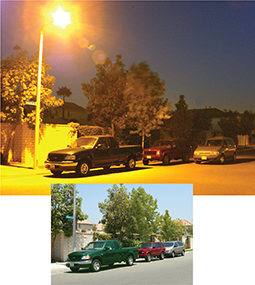Sodium-Vapor Light
Sodium-vapor lights contain a small amount of solid sodium, as well as a mixture of neon and argon gases.  As electric current passes through a sodium-vapor bulb, it ionizes the gas mixture. The mixture warms up and the heat causes the sodium to change from a solid into a gas. The current of electrons knocks electrons in sodium to higher energy levels. When the electrons move back to lower energy levels, the sodium atoms emit light. Sodium-vapor lights are energy efficient and give off very bright light. Many streets and parking lots are illuminated with sodium-vapor lights. Figure 29 shows how sodium-vapor light produced with neon and argon can alter the color of the objects it illuminates.
As electric current passes through a sodium-vapor bulb, it ionizes the gas mixture. The mixture warms up and the heat causes the sodium to change from a solid into a gas. The current of electrons knocks electrons in sodium to higher energy levels. When the electrons move back to lower energy levels, the sodium atoms emit light. Sodium-vapor lights are energy efficient and give off very bright light. Many streets and parking lots are illuminated with sodium-vapor lights. Figure 29 shows how sodium-vapor light produced with neon and argon can alter the color of the objects it illuminates.
Tungsten-Halogen Light
Tungsten-halogen light is produced in much the same way as incandescent light. But unlike incandescent lights, a tungsten-halogen's bulb has a small amount of a halogen gas, such as iodine, bromine, or fluorine.  Inside a tungsten-halogen bulb, electrons flow through a tungsten filament. The filament gets hot and emits light. The halogen gas reduces wear on the filament, so tungsten-halogen bulbs last longer than incandescent bulbs. The bulb of a tungsten-halogen light is made of quartz, because quartz has a high melting point. If glass were used, it would start to melt when the bulb got hot.
Inside a tungsten-halogen bulb, electrons flow through a tungsten filament. The filament gets hot and emits light. The halogen gas reduces wear on the filament, so tungsten-halogen bulbs last longer than incandescent bulbs. The bulb of a tungsten-halogen light is made of quartz, because quartz has a high melting point. If glass were used, it would start to melt when the bulb got hot.
Figure 29 The yellow color of sodium-vapor light makes objects look different than they look in sunlight.

Section 18.5 Assessment
Reviewing Concepts
 Name six common sources of light.
Name six common sources of light. Describe how each type of bulb produces visible light.
Describe how each type of bulb produces visible light.Why are fluorescent light bulbs often used in office buildings and schools?
List three uses for lasers.
How are tungsten-halogen bulbs different from incandescent bulbs?
Critical Thinking
Comparing and Contrasting How are the six main types of lights similar? How are they different?
Applying Concepts Why do some bulbs heat up more than others?
Formulating Hypotheses A friend rubs a compact fluorescent bulb on her shirt on a dry day, and the bulb lights up for a moment. Propose a hypothesis to explain why.
Connecting Concepts
Energy Review the types of energy in Section 15.1: mechanical, chemical, thermal, electrical, electromagnetic, and nuclear. Then pick two light sources and describe the energy changes in each after you turn on the light.




